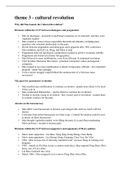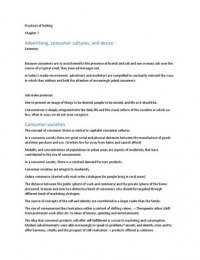theme 3 - cultural revolution
Why did Mao launch the Cultural Revolution?
Divisions within the CCP between ideologues and pragmatists
Mao an ideologue - accused Liu and Deng's measures as 'revisionism', and they were
'capitalist roaders'
Mao wanted to remove those responsible that held old attitudes, including party
members who tolerated intellectuals in the party
Divide between pragmatists and ideologues more apparent after 1962 conference -
Mao withdrew and left Liu, Deng, and Zhou to lead
Pragmatists believed ideological compromises needed to achieve economic stablitly
Pragmatists also believed in better foreign policy
Mao believed in mass mobilisation, even if not efficient. It continued revolution
1963 Socialist Education Movement - preached communist values and targeted
corruption
Mao wanted to use mass mobilisation to attack corrupt party officials - Liu controlled
program - made Mao unhappy
it was a power struggle waged behind the smokescreen of a ficticious mass
movement’
The quest for permanent revolution
Mao needed mass mobilisation to continue revolution - people more likely to be loyal
if they join in
Mao condemned Khrushchev - said he failed to continue the revolution
Needed to include young in revolution - they weren't part of revolution - needed them
to commit violence for the party
Attacks on the bureaucracy
Mao didn't want bureaucrats to become a priveleged elite and lose touch with the
masses
Criticisms from urban bureaucrats on Great Leap - Cultural Revolution could be seen
as attack on these bureaucrats
Mao thought 'capitalist roaders' were filling the party (Liu and Zhou moderating
Mao's policies) - needed to cleanse party
Divisions within the CCP between supporters and opponents of Mao's policies
Mao's main supporters - Lin Biao, Jiang Qing, Kang Sheng, Chen Boda
Mao's main opponents - Liu Shaoqi, Deng Xiaoping, Chen Yun, Bo Yibo
1964 - Mao accuses Liu of choosing 'capitalist road'. Accuses Deng of running own
kingdom
1965 - Attack on Wu Han (wrote a contreversial play). Mao targeted Peng Zhen (Wu's
boss), one of Liu's allies.
Lin Biao escalated into crisis
March 1966 - Mao assigned Liu to remove Peng Zhen from office
, CCRG set up to control Cultural Revolution. Could be blamed for mistakes
Liu and Deng still believed they were in control - just a culture remodelling
May 1966 - Kang Sheng pushes wall poster campaigns
Liu and Deng try to control campaign - Mao not happy - wanted chaos!
July 1966 - Mao swims in Yangtze river - show of strength
Mao forces Liu and Deng to make self-criticisms
How effective were the red guards in carrying out the cultural revolution?
Mao's hold on young people
Would help ensure long-term survival of communism ideology
Realised their enthusiasm
Able to control through personalilty cult and 'little red book'
Personality cult seperated Mao from the party - Mao a hero, party repressive and a
threat to Mao's achievement, because there were too many 'capitalist roaders'
Mass rallies made students feel involved - also peer pressure
Young people with 'wrong' class backgrounds were keen to join revolution
The mass rallies of 1966
18th August 1966 - Mao greets 1 million Red Guards in Tiananmen Square
Chaos followed - destruction of '4-olds' etc.
PLA helped organise rallies - transport and rail passes etc.
Seen as opportunity to do 'revolutionary tourism'
Mass rallies created sense of solidarity and meant actions were approved
The attacks on the '4-olds'
Old culture, old ideas, old customs, old habits - deliberately vague
Young people more willing to destroy 'old' things
Lin Biao instructed Red Guards to attack them on 18th August
Red Guards targeted Western things - shaved Western haircuts
Wanted to change colours of traffic lights (red to be 'go')
Houses sacked, books burnt, authors given struggle sessions (tortured and beaten)
Attacks on religion - clergymen imprisoned
Divide between children and parents
Jiang Qing given responsibility to 'purify' culture
Some old attitudes survived - e.g respect for dead (gathering for dead Zhou Enlai)
The growth of anarchy and the use of terror
Few restrictions - police and PLA not involved
Teachers, petty bourgeosie etc. subject to struggle sessions - forced to confess crimes
Attacks random at first, became more systematic
Lots of people killed and executed
Formation of Red Guard units by factory and office workers
Units of bourgeosie-background students
In-fighting between Red Guard units in Shanghai. Mao placed Committee to control
them
Why did Mao launch the Cultural Revolution?
Divisions within the CCP between ideologues and pragmatists
Mao an ideologue - accused Liu and Deng's measures as 'revisionism', and they were
'capitalist roaders'
Mao wanted to remove those responsible that held old attitudes, including party
members who tolerated intellectuals in the party
Divide between pragmatists and ideologues more apparent after 1962 conference -
Mao withdrew and left Liu, Deng, and Zhou to lead
Pragmatists believed ideological compromises needed to achieve economic stablitly
Pragmatists also believed in better foreign policy
Mao believed in mass mobilisation, even if not efficient. It continued revolution
1963 Socialist Education Movement - preached communist values and targeted
corruption
Mao wanted to use mass mobilisation to attack corrupt party officials - Liu controlled
program - made Mao unhappy
it was a power struggle waged behind the smokescreen of a ficticious mass
movement’
The quest for permanent revolution
Mao needed mass mobilisation to continue revolution - people more likely to be loyal
if they join in
Mao condemned Khrushchev - said he failed to continue the revolution
Needed to include young in revolution - they weren't part of revolution - needed them
to commit violence for the party
Attacks on the bureaucracy
Mao didn't want bureaucrats to become a priveleged elite and lose touch with the
masses
Criticisms from urban bureaucrats on Great Leap - Cultural Revolution could be seen
as attack on these bureaucrats
Mao thought 'capitalist roaders' were filling the party (Liu and Zhou moderating
Mao's policies) - needed to cleanse party
Divisions within the CCP between supporters and opponents of Mao's policies
Mao's main supporters - Lin Biao, Jiang Qing, Kang Sheng, Chen Boda
Mao's main opponents - Liu Shaoqi, Deng Xiaoping, Chen Yun, Bo Yibo
1964 - Mao accuses Liu of choosing 'capitalist road'. Accuses Deng of running own
kingdom
1965 - Attack on Wu Han (wrote a contreversial play). Mao targeted Peng Zhen (Wu's
boss), one of Liu's allies.
Lin Biao escalated into crisis
March 1966 - Mao assigned Liu to remove Peng Zhen from office
, CCRG set up to control Cultural Revolution. Could be blamed for mistakes
Liu and Deng still believed they were in control - just a culture remodelling
May 1966 - Kang Sheng pushes wall poster campaigns
Liu and Deng try to control campaign - Mao not happy - wanted chaos!
July 1966 - Mao swims in Yangtze river - show of strength
Mao forces Liu and Deng to make self-criticisms
How effective were the red guards in carrying out the cultural revolution?
Mao's hold on young people
Would help ensure long-term survival of communism ideology
Realised their enthusiasm
Able to control through personalilty cult and 'little red book'
Personality cult seperated Mao from the party - Mao a hero, party repressive and a
threat to Mao's achievement, because there were too many 'capitalist roaders'
Mass rallies made students feel involved - also peer pressure
Young people with 'wrong' class backgrounds were keen to join revolution
The mass rallies of 1966
18th August 1966 - Mao greets 1 million Red Guards in Tiananmen Square
Chaos followed - destruction of '4-olds' etc.
PLA helped organise rallies - transport and rail passes etc.
Seen as opportunity to do 'revolutionary tourism'
Mass rallies created sense of solidarity and meant actions were approved
The attacks on the '4-olds'
Old culture, old ideas, old customs, old habits - deliberately vague
Young people more willing to destroy 'old' things
Lin Biao instructed Red Guards to attack them on 18th August
Red Guards targeted Western things - shaved Western haircuts
Wanted to change colours of traffic lights (red to be 'go')
Houses sacked, books burnt, authors given struggle sessions (tortured and beaten)
Attacks on religion - clergymen imprisoned
Divide between children and parents
Jiang Qing given responsibility to 'purify' culture
Some old attitudes survived - e.g respect for dead (gathering for dead Zhou Enlai)
The growth of anarchy and the use of terror
Few restrictions - police and PLA not involved
Teachers, petty bourgeosie etc. subject to struggle sessions - forced to confess crimes
Attacks random at first, became more systematic
Lots of people killed and executed
Formation of Red Guard units by factory and office workers
Units of bourgeosie-background students
In-fighting between Red Guard units in Shanghai. Mao placed Committee to control
them




